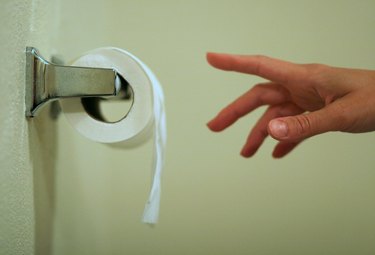
It'd be pretty strange to invite anyone to look at your poop in the toilet bowl (unless you're a 5-year-old), but if someone did do that today, they might be able to tell what you ate recently. Yep, sometimes a piece of undigested broccoli, asparagus or corn can reveal itself in all its glory in your poop.
What's up with that? And is it something to be worried about?
Video of the Day
Video of the Day
"There are a lot of foods we eat that are not completely digestible by the human gastrointestinal (GI) tract," Carolyn Newberry, MD, a gastroenterologist at NewYork-Presbyterian and Weill Cornell Medicine in New York City, tells LIVESTRONG.com. "It's very normal to see small pieces of food in the stool."
Occasionally, though, it might be a sign that something's not quite right.
Here are three no-big-deal reasons for undigested food in your poop, and one that might be cause for concern.
1. You’re Loading Up on Veggies
A random broccoli piece in your poop could actually mean you're including the right foods in your diet, so maybe pat yourself on the back?
Veggies pack a lot of good fiber, and your digestive enzymes can't break down all of it.
"That's why fiber is so helpful," Dr. Newberry says. "It bulks up the stool, makes it easier to pass and decreases the risk of constipation, diarrhea and cancer."
2. You’re Eating Foods With a Tough Outer Shell
Did someone eat corn on the cob recently?
When it comes to pooping undigested food, "corn is probably the number-one culprit," gastroenterologist Cecilia Kelly, MD, a clinical associate professor at Thomas Jefferson University in Philadelphia, tells LIVESTRONG.com.
That's because corn has a tough, fibrous outer shell that makes it resistant to breaking down. Plus, the way you eat corn and the kernels' size and shape make them more likely to show up on the other end — if you're taking a scoop or a big bite, you might not chew every piece and instead you'll swallow a kernel whole or half-eaten.
3. You're Rushing Through Your Meal
Eating quickly or while distracted may mean you're not chewing your food fully, Dr. Kelly says. Digestion begins in your mouth as you chew, so make sure you're adequately munching to make things easier on the digestive process.
Plus, if weight loss is a goal of yours, know that chewing more increases the release of gut hormones that decrease appetite and help you eat less, according to a November 2015 study in Physiology & Behavior.
4. You Have a GI Disorder
The appearance of food fragments themselves isn't a big worry, unless you're also experiencing other symptoms.
"Nausea, vomiting, severe abdominal pain after eating or unexpected weight loss indicates a nutrient absorption problem," Dr. Newberry says.
While 95 percent of your calories and nutrients are absorbed in the small intestine, if there's inflammation, blockage or disease there, you may not get the carbs, fats, proteins, vitamins and minerals you need from food.
"This can lead to weight loss, gastrointestinal symptoms, as well as skin and vision changes from deficiencies," she says.
GI diseases including Crohn's, celiac and pancreatic cancer can cause malabsorption, and you may particularly notice the appearance of fat in your stools. If you're seeing this, make an appointment with your doctor to be assessed.
Is this an emergency? If you are experiencing serious medical symptoms, please see the National Library of Medicine’s list of signs you need emergency medical attention or call 911.